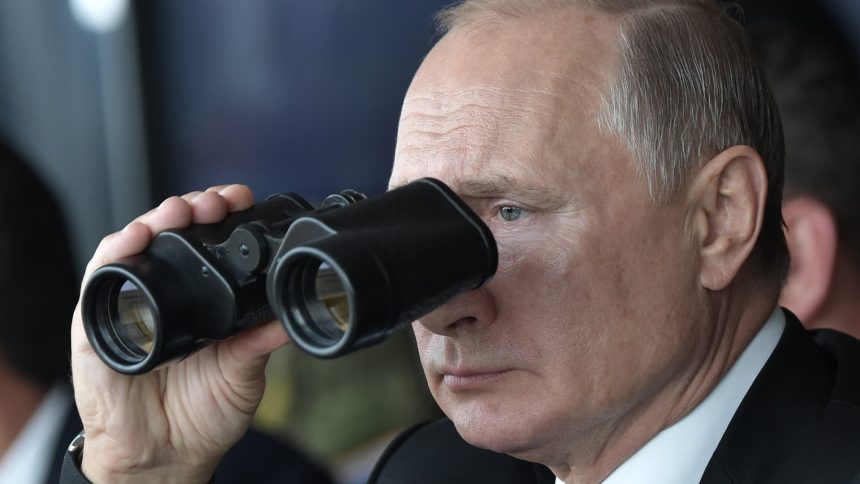A sharp rise in drone attacks targeting Russian territory is likely to intensify, analysts say, with Kyiv appearing increasingly determined to bring the destruction, instability and unpredictability of war — albeit a fraction of what it is experiencing itself — home to Russia.
Russia has seen a sharp rise in unmanned aerial vehicles, or UAVs, carrying out assaults on western, central and southern Russian regions as well as the capital Moscow and Russian-occupied Crimea in recent weeks.
While Ukraine is continuing a counteroffensive on its own soil to regain Russian-occupied territory in the south and east of the country, and aiming to break Russia’s so-called “land-bridge” to occupied Crimea, the increasing use of drones to assault Russian soil shows another facet of Ukraine’s military strategy.
“The war is coming home to Russia,” Timothy Ash, emerging markets strategist at BlueBay Asset Management, said in emailed comments Wednesday.
“Ukraine is demonstrating that it can make life very difficult for Russia, Russians and Putin,” he added.
“With attacks in Crimea itself, and the land corridor and the Kerch bridge, and Russian shipping in the Black Sea coming under attack the clear message is that while the invasion was partially sold as an effort to improve Russian security, it has made Crimea and Russia less secure for Russian forces.”
“And it is only going to get worse as long as this invasion continues,” Ash added.
Aerial assaults have intensified in recent days with strikes occurring further into Russian territory. In the early hours of Wednesday morning at least six Russian regions reported attempted drone attacks, one of which destroyed and damaged four military transport planes at an airfield in northwestern Russia.
More attacks followed overnight Thursday, with further drones shot down in the Moscow area and the Bryansk region of southern Russia that borders Ukraine. Airports in targeted regions have been forced to cancel and delay multiple flights as a result of the attacks.
Drone warfare
Russia blamed Ukraine for the latest drone attacks while Ukraine remained characteristically tight-lipped about these, and previous, assaults. It’s undeniable that UAVs have become a crucial weapon in both Russia and Ukraine’s arsenals, however.
Ukraine has been targeted with thousands of Russian drone attacks during the 19-month-long conflict, with its energy, defense and civilian infrastructure pummeled by swarms of Iranian-made UAVs. On Tuesday night, Kyiv said it had repelled more than 20 drone and missile attacks on the capital.
In recent months, Russia has experienced more drone assaults too, however, with military bases, airfields and fuel depots, as well as neighborhoods in Moscow, targeted. Experts agree that Ukrainian forces direct attempts to attack Russian territory and are likely to be assisted by disaffected anti-war Russians at times.
While drone attacks are causing a headache for Moscow on a military and political level, forcing the country to re-allocate air defense complexes to its own territory, analysts say they’re unlikely to destabilize Russian President Vladimir Putin’s regime unless an attack directly affects the elite.
“All these drone attacks force the Russian Ministry of Defense to distribute its limited number of defense assets deeper into Russia, for example, moving them from the frontlines to Moscow and airfields on Russian internationally recognized territory,” Kirill Shamiev, a Russian political scientist and a visiting fellow at the European Council on Foreign Relations, told CNBC Thursday.
“This is especially important for these limited number of assets such as Pantsirs, which are good and powerful [anti-aircraft missile] systems on the frontlines, but now they need to bring some of them home. So this basically reduces the effectiveness there when they’re fighting Ukrainians,” he noted.
Shamiev said the increase of attacks on Russian territory was unlikely to cause a stir among Russian society, given that it was not close-knit and there had been few deaths from drone attacks.
Still, if UAVs continued to be used to target the more elite neighborhoods of Moscow, those where Putin’s allies and associates live, that could pose a problem for the Kremlin.
“If these drones continue hitting targets inside Moscow, and especially if they kill somebody, among the people closer to the Kremlin, this would be unfortunate and this is something they want to prevent from happening … I think they would rather prefer Ukrainians hit military targets than the civilian political infrastructure in Moscow, for example,” Shamiev said.
CNBC has requested a response to these comments and is awaiting a reply from the Kremlin.
Drone production set to increase
Ukraine’s President Volodymyr Zelenskyy said in mid-August that Kyiv was working to significantly increase its drone production, aiming to manufacture UAVs with different ranges and different purposes.
“Production is necessary. We are increasing production significantly. However, we need to systematize what is already being supplied to the troops and used. Drones are the “eyes” and protection on the frontline,” Zelenskyy said in a nightly address, adding that “drones are a guarantee that people will not have to pay with their lives when drones can be used.”
Oleksandr Musiyenko, a military expert and head of the Centre for Military and Legal Studies in Kyiv, told CNBC he expected drone attacks to intensify further as Ukraine increased domestic drone production further.
“I think that the scale of these attacks will be higher .. Ukraine has tried to use different types of drones to launch attacks on Russian military objects, on Russian objects of the defense industry. And I think that these drones can be the game changer in the Russia-Ukrainian war,” he told CNBC Thursday.
“We do not have different types of missiles like Russia has, but we will increase the production of different types of drone.” “It’s very important for us,” he noted.
Read the full article here




